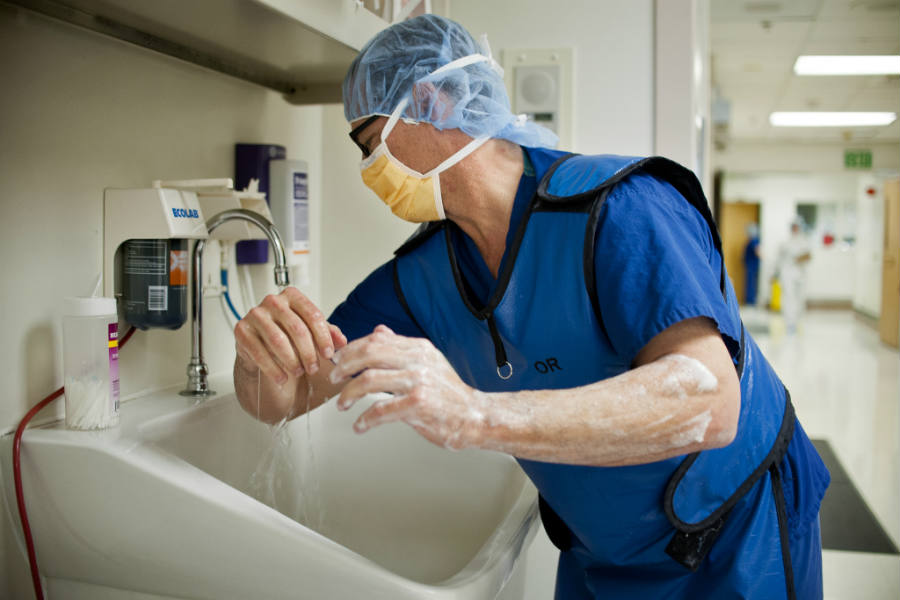In California, researchers proved that healthcare providers might care most to hand hygiene compliance when they are aware they are being observed.
The study was carried out at the Santa Clara Valley Medical Center (SCVMC), researchers concluded that care professionals tend to the Hawthorne Effect. The Hawthorne effect is a condition in which individual change their behavior when they know someone is keeping an eye on them.
This weekend, researchers presented the study at the Association for Professionals in Infection Control and Epidemiology (APIC) conference, finding out that rates of hand hygiene compliance at SCVMC was entirely different when care providers were aware of being evaluated, in contrast to when they were not.

On one hand, they used Infection Prevention nurses, a team who was recognized by hospital’s staff as health monitors. On the contrary, researchers included high school or college students volunteers. But hospital’s workers did not know they were also going to be observed by the young monitors. The younger volunteers were trained by researchers to carry out the observational phase.
The study revealed that the hand hygiene compliance rate followed by Infection Prevention nurses was about 57 percent, while young monitors recorded a compliance rate of just 22 percent. Researchers consider that the gap between both types of monitoring was huge and that they will be launching some strategies to a achieve higher rates regarding hand hygiene compliance in medical institutions.
Does this pic gross you out? Images like these can jumpstart better hospital #handhygiene https://t.co/Z9bhGdHg2F pic.twitter.com/UFWDflvTDa
— The Leapfrog Group (@LeapfrogGroup) June 10, 2016
Hawthorne Effect
It refers to a psychological phenomenon in which individual modify or improve their behavior or performance when they are being monitored. It seems like individuals may change their behavior simply because of they are researchers’ spotlight, they do not perform differently because they want to get different fake results.
Nurses and doctors from the SCVMC presented this condition while being monitored by the two types of auditors who assessed the hand-hygiene study. Health professionals changed their hand care dramatically when they aware of being observed by someone else, but also when they did not know.
Maricris Niles, an infection prevention analyst at SCVMC, said there was a significant gap between what the Infection Prevention nurses were witnessing and what volunteers were seeing. Apparently, there were a much higher compliance rates when the Infection Prevention nurses (those known by hospital staff) were around, and it significantly diminished when the anonymous auditors were assessing care workers.
Proofs for our Hawthorne Effect paper are reviewed and submitted. Excited for the online ahead of print version! #meded #ethnography
— Elise Paradis (@ep_qc) June 1, 2016
Researchers took extra measures to guarantee the gap in the results was not linked to the different types of observers working in the study. What they did found out was the Hawthorne Effect as the leading cause to explain the difference in the principle of hand hygiene among subjects.
According to Lisa Hansford, one of the recognizable Infection Prevention nurses at SCVMC, hospital staff completely changed hand hygiene rules when she was observed arriving at the floor: “When we would come on the ground, I would notice that the nurses or providers were not using the alcohol. Then they would glance up and see me and bend over backward to lather up.”
U.S. hand hygiene compliance campaigns
As per the Center for Disease Control and Prevention (CDC), hand hygiene compliance has been a longstanding issue in the United States. According to the agency, health professionals wash their hands less than half of the time they should and the World Health Organization (WHO) has estimated 40 percent averages concerned with this issue.
Therefore, considering the critical role hand hygiene play in the medical field, the scientific community as well as government agencies have carried out several researchers and campaigns to diminish the low rates of hand hygiene compliance.

In May, The Obama Administration launched the Clean Hands Count Campaign. The campaign aims to improve proper adherence from health workers to CDC’s hand hygiene guidelines, unveil the myths and misperceptions linked to hand hygiene and encourage patients to get involved in their care by reminding healthcare providers to wash their hand before receiving any treatment.
In Detroit, specialists from Henry Ford Hospital showed healthcare workers magnified images of how bacteria might increase when there is poor adherence to hand hygiene practices. Researchers displayed pictures of ordinary places from the hospital containing thousands of bacteria.
The study was carried out as part of an awareness program about hand hygiene. Scientists have said that healthcare workers might forget for a while that the place where they spend the most time of their day is a constant term environment, the study is a sort of reminder for them to retake hand hygiene practice as a priority.
Other healthcare institutions are working with electronic monitoring techniques. Alcohol dispensing stations are observed while care providers get close to the stations. However, some epidemiologists might consider the control strategy as ineffective. They think that human observation may provide accurate results as well as the possibility of giving feedback on each hospital’s worker.
Source: WWAYTV

This article is so far beyond stupid I don’t know where to go. How can this be news for anyone? Who didn’t know that you will act differently if you are being watched at your job? If they did a piece on how doctors don’t wash their hands or that their dirty neckties spread disease might be worth writing about but in this country we have to coddle our quack doctors.